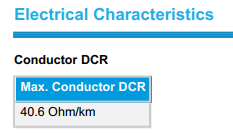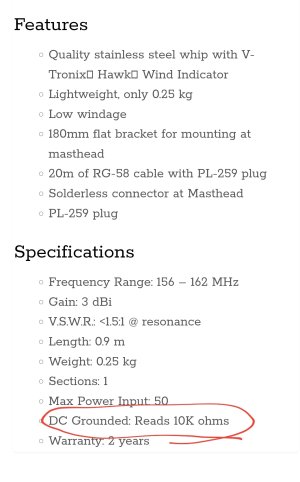Ian_Rob
Well-known member
My VHF is playing up. My Hawk Aerial was replaced this time last year. The resistance at the coax plug is 9.9ohms. Is that within the range of a working antenna?
Thanks
Thanks
The cable supplied with the Hawk Aerial - RG58 C/U.What type of cable are you using?
Fine if you have a connector at the top of the mast and can get up there to disconnect it.End to end on the centre/core, should be virtually 0.00Ω. Core to screen should be infinity ∞, as in no continuity; above 20MΩ. Screen to screen should be 0.00Ω.

Many marine VHF antennas have the centre core of the coax tapped into a small coil of wire that matches the 5/8 wavelength of the vertical section to 50 ohms impedance. The top of the coil goes to the vertical whip and the bottom of the coil goes to the outer sheath of the coax. A resistance of a few ohms to DC at the bottom of the coax on these antennas is quite normal. 9.8 ohms seems a bit high but not beyond the realms of possible. A VSWR bridge will reveal what’s happening.0.08Ω is virtually nothing. Calibrated VDM's are calibrated with the probes in place to ensure accuracy. I agree that the vast majority of meter's aren't going to be 'accurate' to scientific purposes, but they'll generally indicate a fault. On any coax with a fault, there'll be either an open circuit, or a short to screen, or high impedance end to end. It would appear that the OP is measuring 9.9Ω at the plug, I'd imagine that's reading across from centre to screen, which would indicate (to me) a short. Easily inspected at the VHF, but far more likely to have a fault at the exposed top of the mast.

The resistance at the coax plug is 9.9ohms
True. The 50ohms is the ‘impedance’ of the cable. Nothing to do with the DC resistance and we definitely don’t need to start going into transmission line theory here…!And you'll not be able to measure the 50Ω of the cable with a simple multimeter...
I hope the weather is kind to you and you sort your problems out easily.Thanks for all the help. We are, wind permitting, relaunching tomorrow and another issue came up. I will check the readings again tomorrow.